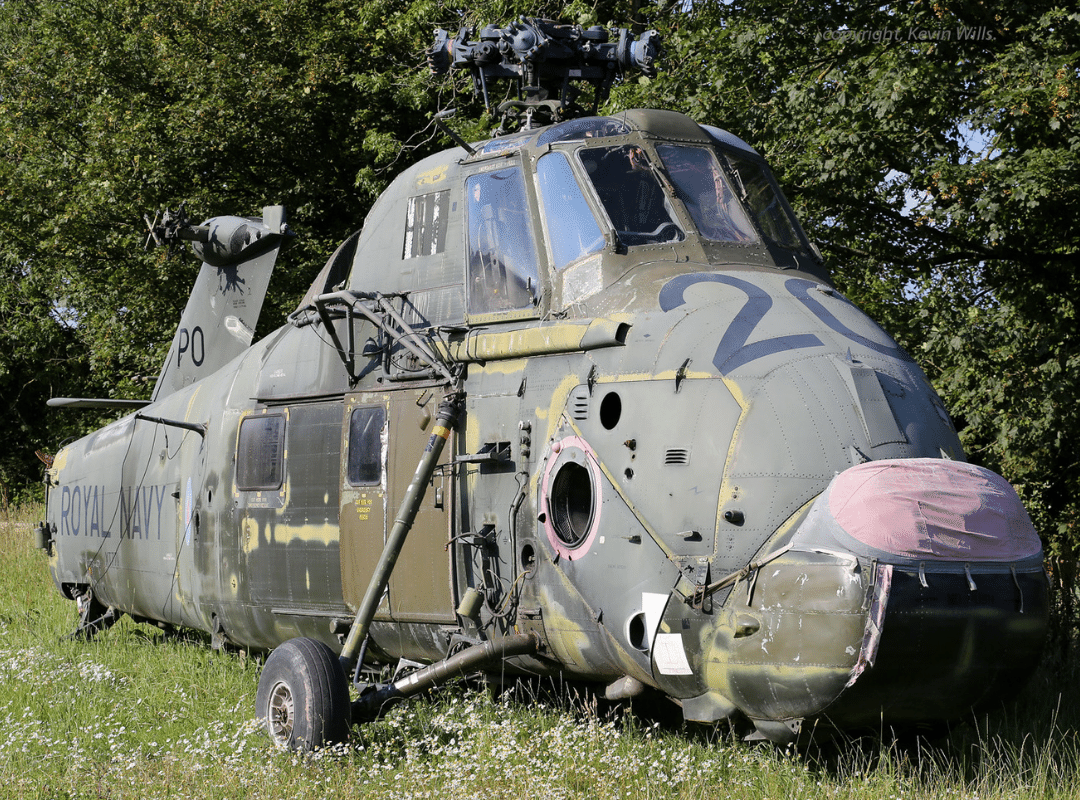Constructors Number WA553
First flight 1967
Taken on strength with the Royal Navy as XT771 6 Dec 67
707 Sqn (“WR/ VL”) 1968
772 NAS (“620/PO”) 1982
Air Electrical/Engineering School, Lee-on-Solent 11 Apr 88: Re-allocated as GI Class GR(2) A2761(2)
AEES, Gosport 14 November 1995: Re-allocated as GI Class GR(2) A2673 (2)
Allocated to RN Historic Flight (TFH 2673) 2006
School of Flight Deck Operations, Culdrose (“620/PO”) by May 2014
The Westland Wessex was a British-built, turbine-powered development of the Sikorsky S-58/H-34. It was developed and produced under license by Westland Aircraft (later Westland Helicopters). One of the main changes from Sikorsky’s S-58/H-34 was the replacement of the piston-engine powerplant with a turboshaft engine. The Wessex was the first large mass-produced helicopter designed around the use of a gas turbine engine. Early models were powered by a single Napier Gazelle engine, while later builds used a pair of de Havilland Gnome engines.
The Wessex was initially produced for the Royal Navy and later for the Royal Air Force; a limited number of civilian aircraft were also produced, as well as some export sales. The Wessex operated as an anti-submarine warfare and utility helicopter; it is perhaps best recognised for its use as a Search and Rescue helicopter. The type entered operational service in 1961, and had a service life in excess of 40 years before being retired in Britain.


TIMELINE
Built at Westland Helicopters, Yeovil and first flown on 9 May 1967
Displayed at the Paris Airshow 24 May 1967
Westland Helicopters, Yeovil – Trial Installation of Beta Formation Lights 7 Jun 1967
Helicopter Holding Unit RNAY Fleetlands 4 Dec 1967
NASU, RNAS Culdrose 12 Dec 1967
707 NAS RNAS Culdrose 1 Apr 1969
Stbd engine problem, engine off landing Culdrose 21 Apr 1969
Co-pilots window lost in flight 11 Jul 1969
NASU, RNAS Culdrose 16 Oct 1969
848 NAS 7 Sep 1970
Port transmission platform opened in flight causing damage 15 Oct 1970
NASU, RNAS Culdrose 11 Feb 1971
707 NAS RNAS Culdrose 13 Jul 1971
Port aft cabin window shattered and blew out off Teignmouth 2 May 1972
707 NAS RNAS Yeovilton heavy landing damage at Yeovilton 18 Jan 1973
Fuselage and pylon damaged during removal of pylon, aircraft moved to RNAY Fleetlands by road 18 Apr 1973 (Cat 4 repair)
707 NAS RNAS Yeovilton 4 Oct 1973
Stbd rear window Perspex lost in flight 4 Jun 1974
848 NAS 19 Apr 1982
NASU, RNAS Yeovilton for repair 24 Apr 1982
845 NAS 29 Apr 1982
To South Tlantic in RFA Olna 10 May 1982
To UK in RFA Olna 30 Aug 1982, arriving Yeovilton 19 Sep 1982
772 NAS SAR Flight Lee on Solent 11 Feb 1983
772 NAS Portland 11 Apr 1983
BAH Gatwick for refinish 24 May 1985
772 NAS Portland 11 Jun 1985
772 NAS SAR Flight Lee on Solent 19 Jul 1986
772 NAS Portland 21 Nov 1986
772 NAS SAR Flight Lee on Solent 1 Dec 1987
772 NAS Portland 30 Mar 1988
Air Engineering School Lee on Solent 11 Apr 1988
Air Engineering & Survival School HMS SULTAN by road 14 Nov 1995
Static display at RNAS Portland for station closure 18 Sep 1998
Air Engineering & Survival School HMS SULTAN by road 19 Oct 1998
Dec 2008 allocated to RN Historic Flight Total Flying Hours 6065:20
Sold and transferred to Historic Helicopters on 5 Jul 2017
Air Engineering School Lee on Solent by road 9 Sep 1991
Air Engineering & Survival School HMS SULTAN by road 6 Nov 1995
Static display at International Festival of the Sea, Portsmouth 24 Aug 1998
Air Engineering & Survival School HMS SULTAN by road 2 Sep 1998
Dec 2008 allocated to RN Historic Flight Total Flying Hours 2776:05
Sold and transferred to Historic Helicopters on 5 Jul 2017
OPERATION BURLAP
The 1970 Bhola Cyclone was a devastating tropical cyclone that struck East Pakistan (later to become The Peoples Republic of Bangladesh) and the State of West Bengal, India on 12 November 1970. It was the deadliest tropical cyclone ever recorded, and one of the deadliest natural disasters in modern times. Up to 500,000 people lost their lives in the storm, primarily as a result of the storm surge that flooded much of the low-lying islands of the Ganges Delta. This cyclone was the sixth cyclonic storm of the 1970 North Indian Ocean cyclone season, and also the season’s strongest, reaching a strength equivalent to a Category 3 hurricane.
The cyclone formed over the central Bay of Bengal on 8 November and travelled north, intensifying as it did so. It reached its peak with winds of 185 km/h (115 mph) on 12 November and made landfall on the coast of East Pakistan that night. The storm surge devastated many of the offshore islands, wiping out villages and destroying crops throughout the region. In the most severely affected Thana, Tazumuddin, over 45% of the population of 167,000 was killed by the storm.
The exact full death toll will never be known, but it is estimated that between 300,000 and 500,000 people lost their lives.
International aid was dispatched from many countries including ships of the Royal Navy and Royal Fleet Auxiliary. During November and December 1970 HMS Intrepid supported relief efforts in the region.
Anchored in the Bay of Bengal she was constantly sending food, clothing and medical supplies from HMS Triumph and herself to locations ashore, where they were distributed to isolated islands in the Ganges Delta by her LCVP’s and LCM’s. In addition a large number of Assault Boats and Wessex Helicopters of 847 NAS were taken on by HMS Intrepid for the Operation.



